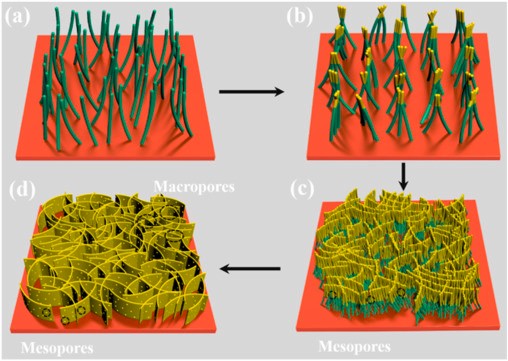Title:Hierarchically porous CuO nano-labyrinths as binder-free anodes for long-life and high-rate lithium ion batteries
Author(s): Jia, Songru; Wang, Yang; Liu, Xueqin*; Zhao, Shiqiang; Zhao, Wen; Huang, Yanqiu; Li, Zhen*; Lin, Zhiqun*
Addresses:, China Univ Geosci, Fac Mat Sci & Chem, Engn Res Ctr Nanogeomat, Minist Educ, 388 Lumo Rd, Wuhan 430074, Hubei, Peoples R China
Source:Nano Energy Volume 59, May 2019, Pages 229-236
DOI:
Published:MAY
Abstract:The ability to rationally design binder-free electrode materials that possess interconnected nanostructures is highly desirable for lithium-ion batteries (LIBs) with long cycling and excellent rate performances. Such electrode containing pores between nanostructures imparts large-area contact with electrolyte, improved electrical conductivity with current collector, and good structural stability and mechanical integrity. Herein, we report, for the first time, outstanding cycling stability and rate performance of CuO electrode in LIBs. CuO nano-labyrinths (NLs) composed of densely interlaced nanowalls on Cu foil are crafted via a facile solution-based etching process. It is notable that macroscopic and mesoscopic pores are found to ubiquitously present among the adjacent CuO nanowalls and within the nanowall, respectively (i.e., forming hierarchically porous CuO NLs). Intriguingly, CuO NLs anodes yield an ultralong cycling stability, that is, a specific capacity of 320 mA h g−1 after 800 cycles without the capacity fading at high current density of 1 A g−1, and an outstanding high-rate performance (up to 30 C). This is a direct consequence of unique synergistic effects of hierarchical pores and interlaced nanostructures. Moreover, a further enhancement of reversible capacity is achieved by deposition Si thin film on the surface of CuO NLs. Such interlaced nanowall-containing structures with hierarchical pores represent an important type of architectures that underpin the development of electrode materials for long cycle-life energy storage devices.
Full Text from Publisher:https://www.sciencedirect.com/science/article/pii/S2211285519301028

